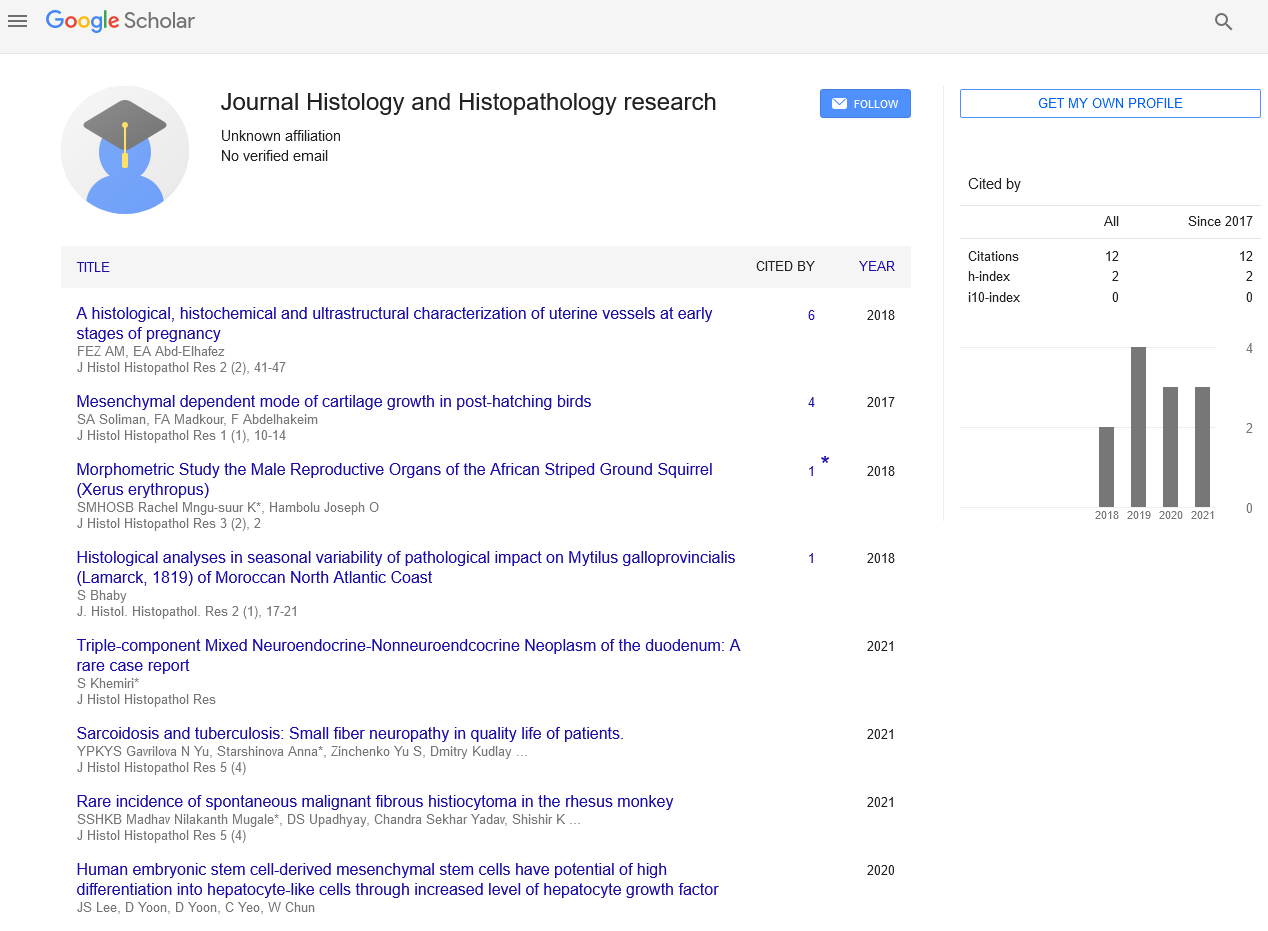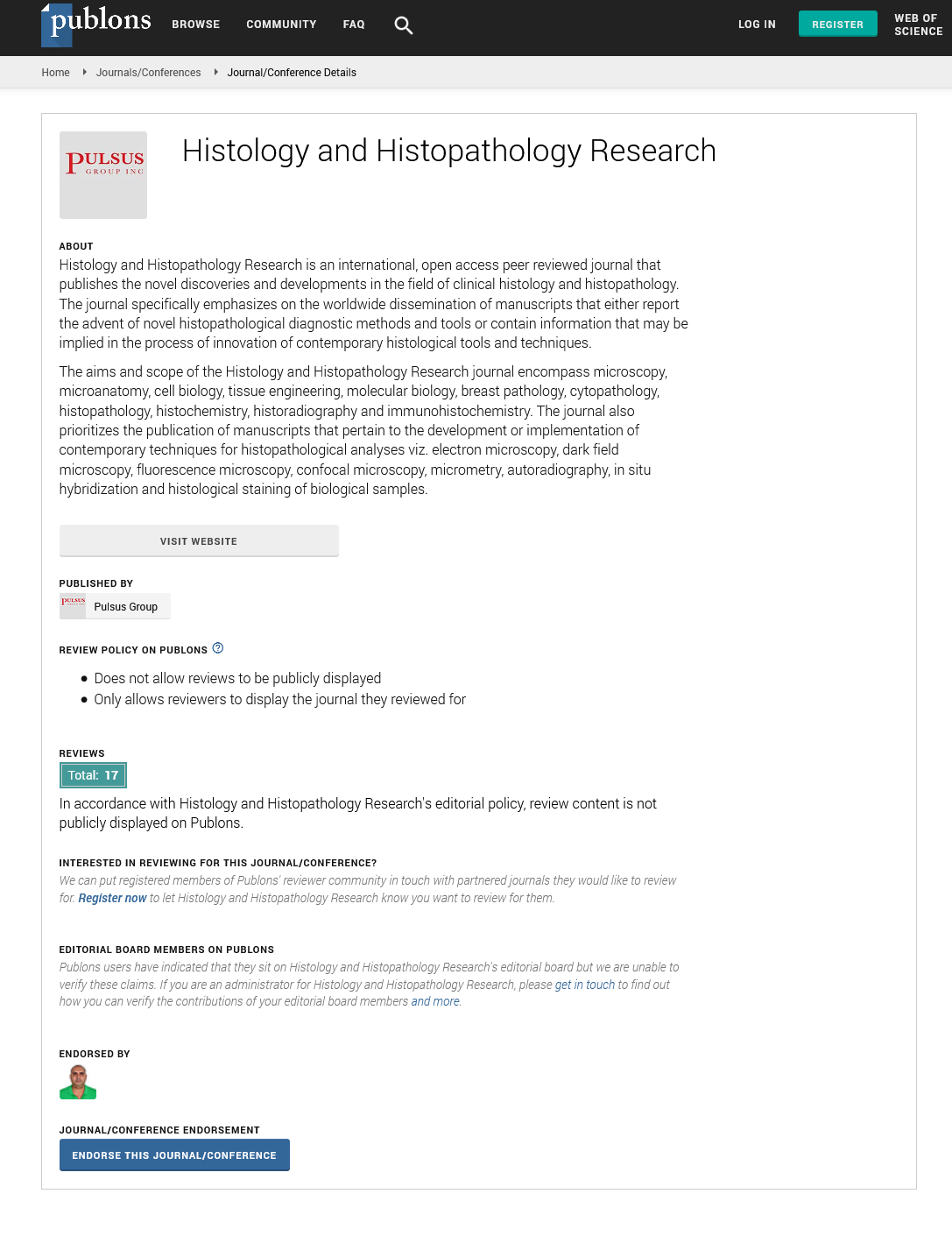The interest of light microscopy for the study of collections: the example of the study of the reproductive biology of a little-known caecilian amphibian
Received: 21-Nov-2017 Accepted Date: Nov 22, 2017; Published: 27-Nov-2017
Citation: Exbrayat JM. The interest of light microscopy for the study of collections: the example of the study of the reproductive biology of a little-known caecilian amphibian. J Histol Histopathol Res 2017;1(1):23-24.
This open-access article is distributed under the terms of the Creative Commons Attribution Non-Commercial License (CC BY-NC) (http://creativecommons.org/licenses/by-nc/4.0/), which permits reuse, distribution and reproduction of the article, provided that the original work is properly cited and the reuse is restricted to noncommercial purposes. For commercial reuse, contact reprints@pulsus.com
At XVIIth century, the microscope permitted the discovery of the smallest living beings. Then histology allowed the understanding of normal and pathological tissues. The use of first staining methods gave a general view of tissues. Methods then developed with histochemistry, immunohistology and in situ hybridization.
The study of living material is currently hard [1]. Yet, all over the world, collections of little known species are stocked into some institutions, becoming tools for biological studies [2]. During a long time, the only technical means to study this material were limited to anatomy, classical histology and histochemistry. Since the end of XXth, it became possible to use powerful methods such as immunohistology and in situ hybridization to study collections with light microscopy. The development of microcomputers, image analysis, let possible a performant quantification of the material preserved. To-day, DNA extraction is applied to materials stored in fixatives, in paraffin-embedded tissues, and from sections already adhered to slides [1,3-5].
The study of a collection with light microscopy made it possible to understand the reproductive patterns of Typhlonectes compressicauda, a South American Caecilian amphibian. The first work, 40 years ago, involved studying male and female sexual cycles related to seasonal variations. The different parts of genital tracts were stained with classical trichrome and histochemical detections [6,7]. In males, the annual and discontinuous sexual cycle was determined using germ cells count in the testes, showing that it was related to wet and dry seasons. The Müllerian ducts have elaborated several secretions. A copulatory organ also varied according to the season [8].
In females, the ovaries varied on a biennial cycle [9]. In December-January, all stages of follicle development were observed. Ovulation occurred from February to April-May.
In pregnant female, corpora lutea persisted into the ovaries. After parturition [September – October], the ovaries with only small follicles, started to develop but the next ovulation didn’t occur and the follicles regressed. The ovary remained in a resting phase until next October at which a new cycle started. The oviducts, varying parallel to ovaries, were divided into a tubal part in which fertilization occurred, and a uterus in which the embryos developed [10]. Variations of female cloaca were also described [8].
The description of the pituitary was first made using the standard staining used to characterize the cells, the size of which varying according to the variation of genital organs [11]. In immunohistochemistry, a correspondence has been established between cell staining and the presence of hormones [12]. For a long time, available antibodies have been directed against proteins, but it has become possible to prepare antibodies directed against steroid hormones. At first only possible on frozen fresh sections, the use of these antibodies being now possible on paraffin section, allowed to give some information about the presence of such hormones in the ovaries [13] and testes [14,15] of Typhlonectes compressicauda. Antibodies to steroid or pituitary hormones receptors provided new insights into the regulation of ovaries and oviducts [16]. The use of antibody has also made it possible to visualize apoptosis [“Apostain” method], and proliferation of cells by the use of Ki67 antibody [17].
In situ hybridization studies of PRL-mRNA expression were performed. In males and non-pregnant females, the total expression of the PRL-mRNAs did not vary throughout the year, unlike the number of PRL cells. In pregnant females, the number of PRL cells varied throughout pregnancy and the expression of PRL-mRNAs increased at the beginning of pregnancy and decreased at the end [18]. In pregnant females, PRL-R mRNAS were expressed in corpora lutea. In males, PRL-R mRNAs were expressed in germ, Sertoli and Leydig cells. The expression of PRL-R mRNAS increased in the Müllerian glands at the time of reproduction and decreased at sexual rest [19]. Between 1979 and 1990, cell counts were performed with an ocular micrometer [20]. Since 2000, cell counting has been performed using a microscope equipped with an image analyzer, [17].
In conclusion, the study of collections with powerful methods is now possible. The study given here is one example of the use of more and more powerful methods. In this example, only the use of embedded material has been described. The data treatment being possible with the progress of microcomputer, gave new results and new interpretations from this material may be given. These methods can be also performed to study clinical samples.
REFERENCES
- Schander C, Halanych KM. DNA, PCR and formalinized animal tissue –a short review and protocols. Org Divers Evol 2003;3:195–205.
- Exbrayat JM. From the knowledge of biology to the use of animal model. Curr Trends Biomedical Engineer Biosci 2017;1(5):555-74.
- Howel JR, Klimstraan DS, Cordon-Cardo C. DNA extraction from paraffin-embedded tissues using a salting-out procedure: a reliable method for PCR amplification of archival material. Histology and Histopathology 1997;12:595-601.
- Sengüven S, Baris E, Oygur T, et al. Comparison of methods for the extraction of DNA from formalin-fixed, paraffin-embedded archival tissues. Int J Med Sci 2014;11(5):494–99.
- Pikor LA, Enfield KSS, Cameron H, et al. DNA extraction from paraffin embedded material for genetic and epigenetic analyses. J Vis Exp 2011;26(49):2763.
- Exbrayat JM. Spermatogenesis and male reproductive system in Amphibia-Gymnophiona. In: Ogielska M, ed. Reproduction of Amphibians, Science Publishers Inc, 2009:25-152.
- Exbrayat JM. Oogenesis and female reproductive system. In Amphibia-Gymnophiona. In Ogielska M, ed. Reproduction of Amphibians, Science Publishers Inc, 2009:306-342.
- Exbrayat JM. Croissance et cycle du cloaque chez Typhlonectes compressicaudus (Duméril et Bibron, 1841), Amphibien Gymnophione. Bull Soc Zool Fr 1996;121(1):99-104.
- Exbrayat JM. Premières observations sur le cycle annuel de l'ovaire de Typhlonectes compressicaudus (Duméril et Bibron, 1841), Batracien Apode vivipare. C R Acad Sci 1983;296:493-8.
- Exbrayat JM. Croissance et cycle des voies génitales femelles de Typhlonectes compressicaudus (Duméril et Bibron, 1841), Amphibien Apode vivipare. Amphibia Reptilia 1988;9:117-34.
- Exbrayat JM. The cytological modifications of the distal lobe of the hypophysis in Typhlonectes compressicaudus (Duméril and Bibron, 1841), Amphibia Gymnophiona, during the cycles of seasonal activity. I - In adult males. Biol Struct Morph 1989;2(4):117 - 123.
- Exbrayat JM, Morel G. The cytological modifications of the distal lobe of the hypophysis of Typhlonectes compressicaudus (Duméril and Bibron, 1841), Amphibia Gymnophiona, during the cycles of seasonal activity. II - In adult males. Biol Struct Morph 1991;3 (4):129-38.
- Exbrayat JM. Reproduction et organes endocrines chez les femelles d'un Amphibien Gymnophione vivipare, Typhlonectes compressicaudus. Bull Soc Herp Fr 1992;64:37-50.
- Anjubault E, Exbrayat JM. Yearly cycle of Leydig-like cells in testes of Typhlonectes compressicaudus (Amphibia, Gymnophiona). In Miaud C, Guyetant R, eds. Current Studies in Herpetology, 1999:53-8.
- Anjubault E, Exbrayat JM. Contribution à la connaissance de l’appareil génital de Typhlonectes compressicauda (Duméril et Bibron, 1841), Amphibien Gymnophione. II. Croissance des gonades et maturité sexuelle des mâles. Bull mens Soc Linn Lyon 2004;73(10):393-405.
- Raquet M. Variations saisonnières et régulation hormonale des voies génitales femelles chez un amphibien ovipare et un amphibien vivipare. PhD dissertation, Ecole Pratique des Hautes Etudes, Lyon, 2014.
- Raquet M, Brun C, Exbrayat JM. Patterns of apoptosis and proliferation throughout the biennial reproductive cycle of viviparous female Typhlonectes compressicauda (Amphibia, Gymnophiona). Int J Mol Sci 2017;18(16).
- Exbrayat JM, Morel G. Prolactin (PRL)-coding mRNA in Typhlonectes compressicaudus, a viviparous gymnophionan Amphibian. An in situ hybridization study. Cell Tissue Res 1995;280:133-8.
- Exbrayat JM, Morel G. Visualization of gene expression of Prolactin-Receptor (PRL-R) by in situ hybridisation in reproductive organs of Typhlonectes compressicauda, a Gymnophionan Amphibia, Cell Tissue Res 2003;312(3):361-7.
- Exbrayat JM, Sentis P. Homogénéité du testicule et cycle annuel chez Typhlonectes compressicaudus (Duméril et Bibron, 1841), Amphibien Apode vivipare. C R Acad Sci Paris 1982;294:757-62.






